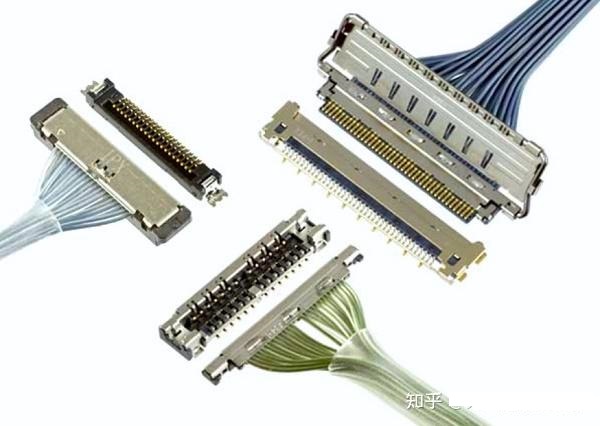Categorization:Harness Component
In today's era of continuous evolution in high-speed transmission and miniaturized design, "extremely thin coaxial cable (Micro Coaxial Cable)" has become a frequently appearing keyword in AI vision modules, notebook cameras, vehicle imaging systems, and drone designs.
But in actual selection, many engineers often encounter a common problem: after the cable is determined, how should the connector be chosen?
In order to truly understand the performance of the entire system, it is essential to first clarify what a "micro coaxial connector" is and what kind of synergistic relationship it has with a micro coaxial cable.
What is a ultra-fine coaxial connector?
Extremely fine coaxial connectors are a miniature interface specifically designed for Micro Coax cables.
Its internal structure is composed of multiple layers of components such as the central needle, insulator, shielding layer, and shell, aiming to achieve reliable signal connection and impedance matching in a minimal space.
Compared with traditional RF connectors such as SMA, MCX, ultra-thin coaxial connectors have a smaller size, with the spacing typically only 0.25mm~0.5mm. They belong to micro-spaced, high-density structures, and are very suitable for the transmission of high-speed signals within the device.
Common series include:
I-PEX 20373 / 20454
Hirose DF36 / DF81
JAE FI-R / FI-X
These products are widely used in laptop cameras, AI vision modules, industrial cameras, and automotive display modules.
They are not only small in size and light in weight, but also have excellent shielding performance, supporting high-speed data transmission of up to and beyond 5Gbps to 10Gbps.
The collaborative relationship between ultra-fine coaxial cables and connectors
The extremely thin coaxial cable can be likened to "the blood vessel of signals", while the connector is "a precise joint".
Cables are responsible for transmitting high-speed signals, while connectors are responsible for stable connection, mechanical fixation, and signal conversion. Only when both are closely matched can the complete signal quality be maintained at the connection point.
Micro Coax line structure is extremely precise:
Conductors are generally made of silver-plated copper wire (AWG 40~42).
Outer diameter is only about 0.25~0.5mm.
Equipped with multi-layer insulation and shielding design.
Connectors should use high-precision stamping and gold-plated terminals, and employ 360° shielded welding to prevent electromagnetic interference and signal crosstalk.
If the connector design or welding process is poor, even if the cable performance is high, problems such as impedance突变, signal反射, or eye diagram塌陷 may occur.
Therefore, many manufacturers offer solutions not as standalone cables or connectors, but as complete harness + connector systems that have undergone full MIPI or USB4 conformance testing to ensure signal integrity and stability.
Why can't AI and imaging systems do without it?
AI vision, autonomous driving, and industrial inspection image modules have extremely high requirements for bandwidth, flexibility, and space occupation.
Traditional FPC ribbon cables have limitations in terms of anti-interference, bend life, and signal consistency, while Micro Coax cable assemblies have distinct advantages:
Strong anti-interference capability: 360° full shielding structure, which can effectively isolate external electromagnetic noise.
High signal consistency: The impedance of each line is controlled within 90Ω±10%, ensuring multi-channel signal synchronization.
Excellent flexibility and bendability: suitable for wiring in narrow spaces, especially for foldable screens or camera modules.
Therefore, the high-speed transmission between AI motherboards and camera module groups almost always uses the Micro Coax solution. Whether it is a four-channel or an eight-channel design, it can achieve both high-speed and stable performance.
Four, the "Invisible Barrier" of Manufacturing and Assembly
Although the appearance seems simple, the processing requirements for extremely fine coaxial fiber bundles are very high.
Taking AWG42 as an example, its central conductor is finer than a hair, and stripping, welding, and crimping all rely on high-precision equipment.
The spacing of connector焊接 points is usually less than 0.3mm. Any slight cold solder joints, solder balls, or misalignment can lead to short circuits or signal anomalies.
Therefore, manufacturers that produce high-quality Micro Coax cable usually equip themselves with:
Automatic coaxial cable manufacturing equipment
Vision positioning welding system
TDR high-speed signal tester.
Such manufacturers not only need to have precision processing capabilities, but also must possess a comprehensive high-speed signal verification system to ensure that each wire harness performs stably before leaving the factory.
The extremely fine coaxial cable and its dedicated connectors are known as the "gold combination" in the high-speed interconnect field.
The former provides a high-speed signal path, while the latter ensures a reliable mechanical and electrical connection.
The compatibility of the two directly determines the stability of AI devices and the data transmission rate.
As devices continue to become lightweight and interface speeds increase, the Micro Coax solution is gradually becoming the mainstream interconnection method for AI and industrial vision systems.
I amSuzhou Huichengyuan ElectronicsLong-term focus on the design and customization of high-speed signal cables and ultra-fine coaxial cables, committed to providing customers with stable and reliable high-speed interconnect solutions.
Welcome to contact us for relevant needs or further information.Manager Yin 18913280527 (WeChat same number)。